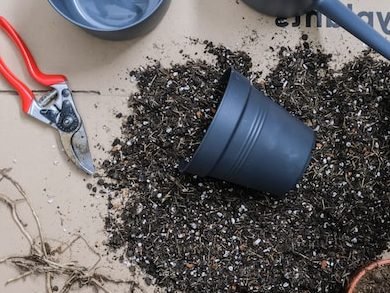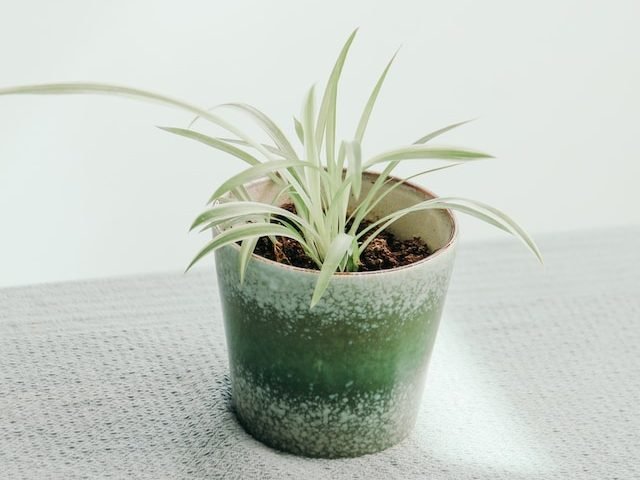
With their dark pink-lined leaves, there’s no wonder that the Calathea Dottie has found itself deep in the hearts of so many plant parents globally. But they aren’t always the easiest plant to care for and it can become quite worrying when your Calathea Dottie starts to develop issues and you don’t know what’s causing them. What’s even more confusing is that a wide range of issues can actually cause the same problem with your Calathea Dottie so you need to know a few other things to look out for to properly diagnose the problem.
In this post, we will cover some of the most common problems that can occur with Calathea Dottie plants so you can not only treat the problem but stop it from harming your plant again in future.
Causes of yellow leaves on Calathea Dottie plants
Overwatering.
Too much water and waterlogged soil tend to be the most common reason why Calathea Dottie plants develop yellow leaves. If the roots are in waterlogged soil for too long they will start to rot, which cuts off your plant from needed nutrients, moisture and oxygen.
If you have a moisture meter, you can use this to check the water levels in the soil, but otherwise taking your plant out of the pot and inspecting the soil will also help you determine if this is the cause of the yellow leaves. Make sure you leave enough time between waterings for the potting mix to dry out and this should prevent more yellow leaves in future.
Intense sunlight levels.
If you don’t seem to be overwatering your Calathea Dottie, then direct sunlight might be causing the yellow leaves on your plant. This mostly happens during summer when the sun is stronger and out for more of the day. If your plant is too close to the window then the sun can actually burn the leaves, causing yellow patches across your Calathea Dottie. Although the yellowing is irreversible, moving your Calathea Dottie to a slightly shadier spot will prevent any more yellow patches from forming.
A pest infestation.
A rarer but definitely more worrying cause of yellow leaves is a pest infestation and this is one cause that is especially important to catch early. Give your Calathea Dottie a thorough check with a magnifying glass to see if you can spot any bugs on the leaves. If you do spot pests on your Calathea Dottie, then move it away from all other plants immediately and treat with neem oil daily for a week or two.
The natural ageing process.
If none of the other causes fit with what’s happening with your Calathea Dottie, then it might simply be the natural ageing process. As your Calathea Dottie matures, it will sometimes lose a leaf or two and use that saved energy to grow new bigger leaves. Often these leaves will turn a solid yellow in colour before falling off your Calathea Dottie. This is nothing for you to worry about as long as the rate of yellowing continues to be a couple of leaves a year.
Why is my Calathea Dottie losing leaves?
Low temperatures.
A nice warm and stable temperature is key to keeping your Calathea Dottie happy and healthy and if your plant is exposed to cold airstreams then this can cause them to lose a few leaves. Keep your Calathea Dottie away from drafty doors and windows and at least 1 metre away from air conditioning vents during summer. We strongly recommend using a digital thermometer to check the temperature that all of your houseplants are in.
Temporary shock or stress.
Plants are sort of like people in that sudden and drastic changes in their environment stress them out quite a bit. This can lead to them losing a few leaves. Shock can be caused by a range of things, for example, moving your plant to a new spot, repotting it or propagation. The good thing about this though is that this stress should be temporary and you shouldn’t see your plant consistently lose leaves. Monitor the leaf loss to make sure that something else isn’t wrong.
Natural ageing.
As we mentioned above with yellow leaves, if your Calathea Dottie is only losing a few leaves each year but nothing in the environment is changing that would indicate stress, then this leaf drop might be natural. This will usually impact the oldest, lowest and smallest leaves and as long as your Calathea Dottie is growing more new healthy leaves then this isn’t a problem you need to worry about.
Why is my Calathea Dottie drooping?
Too much water.
Drooping leaves and stems are one of the early warning signs that your Calathea Dottie is being overwatered. This happens as the roots begin to rot a little and the stems become weakened. Inspect the potting mix immediately as if you are able to catch the issue early, then it can help you avoid more irreversible issues such as brown or yellow leaves. Moving forward to avoid your Calathea Dottie drooping again, make sure to allow the water to fully dry out before watering again.
Too little water.
Funnily enough, the exact opposite can cause the same problem and can cause your Calathea Dottie to droop. This happens when the roots begin to crisp up. Your first instinct might be to give your droopy Calathea Dottie a bucket full of water but this can actually be harmful if the soil moisture level changes suddenly. Instead, you want to reintroduce watering by giving your Calathea Dottie a bit of water each day for one full week and adjust your watering habits in future.
Causes of curling leaves on a Calathea Dottie
Natural curling habits.
Calathea Dottie plants naturally curl their leaves at night and unfold their leaves in the morning. This is where the term ‘Prayer Plant’ comes from as it looks as though the leaves are praying. It can be easy to mistake this curling for an issue but monitor the position of the leaves and if they uncurl during the day, then this isn’t a problem but just their natural trait.
Underwatering.
However, if you notice that the leaves are not uncurling and are permanently curled, then this indicates that there is something wrong with the care/environment that your plant is receiving. Curling up their leaves is one way that plants are able to retain as much moisture as possible so this can indicate underwatering. Inspect the soil to confirm the issue and adjust your watering habits accordingly.
Temperature extremes.
Another factor that can cause Calathea Dottie to curl up their leaves is temperature stress. This can be both extremely high and low temperatures so it’s best to use a digital thermometer to check that the environment is right for your plant. Things like drafts, air conditioning vents, radiators and cookers can lead to extreme temperature fluctuations.
Low humidity levels.
Calathea Dottie plants need a higher than average humidity level to properly thrive and can really struggle in rooms with dry air. Whilst this won’t cause an issue overnight, over time if the air continues to be particularly dry, it can result in your Calathea Dottie curling its leaves. Luckily there are quite a few different ways you can boost the humidity. We recommend misting and buying a humidifier but you can also try pebble trays and moving them into the bathroom (as long as you have good lighting in there).
Alongside good methods to solve the issue, the key thing about reviving your plant is actually spotting the issue early. This will give you the best chance at getting your Calathea Dottie back to full health. We recommend getting into the habit of checking over your plants each time you water them and maybe once a month doing a more in-depth check. This will help you spot any early warning signs and stop the problem from progressing enough to cause irreversible damage to your houseplants.
Check out our Calathea Dottie care guide to learn more about how to best care for your plant.















